Commercially motivated dictionaries and brand communities
Michael Adams
Histories of lexicography suffer from assumptions about which dictionaries deserve our attention and how to value them. We tend to write about big dictionaries that supposedly represent national identities (Le Robert, the academy dictionaries, the OED, Webster’s Third). Most of all, since Samuel Johnson or so, we have celebrated professional lexicographers and their professional products. Such dictionaries are well worth our attention, of course, but we focus on them so much that we overlook dictionaries and glossaries of mundane origins and made for less exclusively lexicographical purposes (but see Nagy 2004). The historians (who often are or have been lexicographers) privilege dictionaries good for nothing else but word research (or door-stopping or booster-seating), whereas dictionaries can serve interests beyond words. Authors and audiences of such dictionaries know it, which may explain why there are so many dictionaries we never write about.
One overlooked sub-genre is the bespoke marketing dictionary, compiled to promote interest in a business or brand. As far as I know, we have no bibliography of such dictionaries, which are often thought of as ephemeral and so less serious than the labor of bibliography demands. Dictionaries of this kind are interesting because, by making them, ordinary people become amateur lexicographers—it’s lexicography of the people, by the people, for the people. It also expresses a belief, or at least a hope, that trading on the authority of dictionaries will somehow pay, not directly, of course, but by building a brand and an associated brand community that responds to dictionaries with pleasure. Usually, commercially motivated dictionaries are free, a sort of promotional literature, although what gets promoted is an interesting cultural story. At the very least, should the belief or hope that a glossary of the right terms would sell stuff prove unjustified, these unimposing works of lexicographical art are back-handed compliments to the success of the dictionary brand, as promoted by major publishers, often to embellish their brands and build their own brand communities.
We must resist, for the moment, pressure to decide who is a professional, who is an amateur lexicographer. Certainly, some very prominent lexicographers have offered their services to commercial interests separate from their dictionaries, royalties from which don’t always pay the bills. For instance, already well-credentialed as a slang lexicographer in the 1980s, Jonathon Green accepted an invitation to write The Language of Food: A Short History of Food Slang Compiled for Batchelors Supernoodles (see Figure 1), which probably appeared in the 1990s, when Batchelors marketed their dried noodle snacks, a sort of British ramen, as “lad food,” perfect for young men too busy with life’s pleasures to cook or eat. At that time, Green was a professional writer, some of whose writing was lexicographical, but his dictionaries started out as celebrations of slang as an index to counterculture, Green’s first love, and only gradually did he become a professional amateur lexicographer. Anyway, The Language of Food figures in the history of lexicography, not only as an example of the ephemeral marketing dictionary, but also as an event in an important lexicographer’s career.
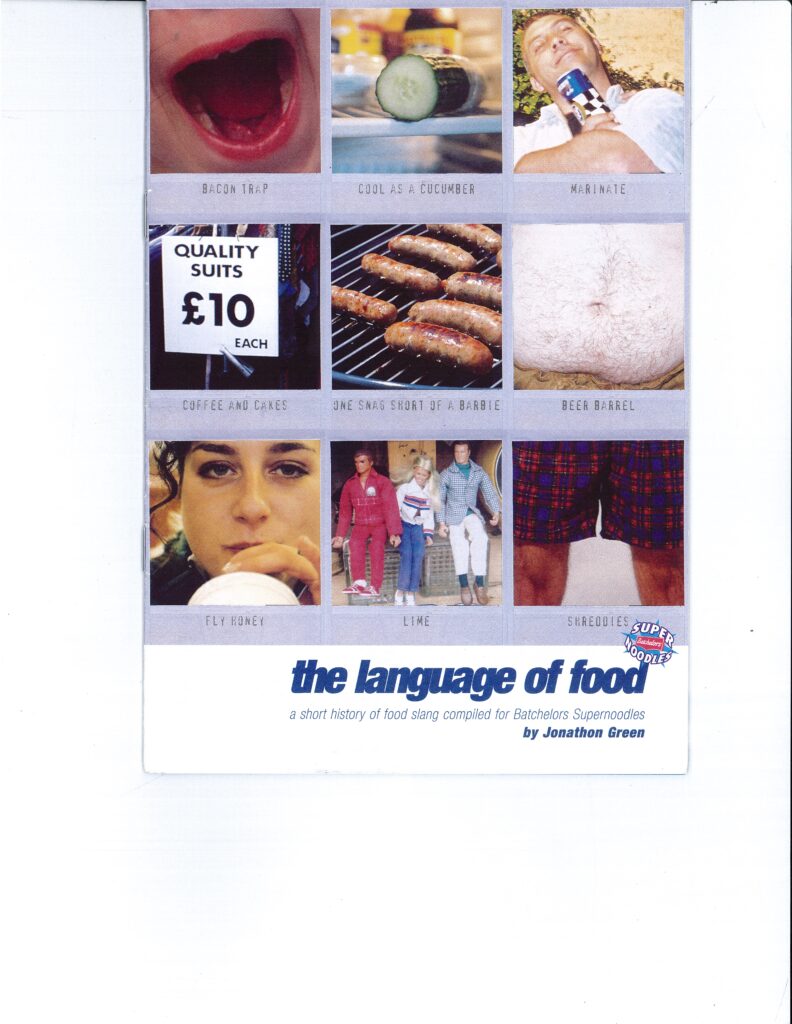
Inside The Language of Food, one finds brief essays on “The new food slang,” and subsequently on slang borrowed from food vocabulary, such as “Terms of endearment” (e.g., sweet pea), “terms of abuse” (e.g., meathead), etc., interspersed with entries for fun food words and phrases, like chippy ‘fish and chips place’ and he irks my tater, which Green defines, “he irritates me (tater being one’s head as in the US college my tater’s torn, I’m very drunk or high).” The Britishness is inescapable. Apparently, the items are rare enough or so specialized that Green didn’t include them in Green’s Dictionary of Slang (henceforth GDoS; 2010). The semi-running foot lists words treated on the page: “beans! cool beans! killer beans! – all general exclamations of approval,” somewhat like the bottom-of-page pronunciation keys in some official dictionaries or head word heads in page corners. Green was the content provider not the designer. The RED Consultancy—still very much a going concern in London’s Soho—led the marketing campaign, and Blue Lemon Design Consultancy designed the booklet.
Green is not the only prominent slang lexicographer to compile a branding glossary, nor Supernoodles the only commercial interest to invest in one. Tony Thorne, whose Dictionary of Contemporary Slang (2014a) has, through several editions, been a respected guide, was enlisted by Spitfire Ales to compile The Word on the Street: The Spitfire Guide to Street Slang (2014b; see Figure 2). This this double-column seven-page compendium enters 317 items, obviously with minimal glosses, the longest of which is “… much? expression of ironic emphasis as in ‘desperate much?’ mocking a friend’s romantic failures.” A single sample sentence for one of the subsequent head words attends the large letter marking each alphabetical section. Again, this adds a footnote to Thorne’s biography but also to the history of dictionaries, glossaries, or works in that style put to commercial use. It’s interesting that Spitfire thought a glossary of slang would give it street cred and that street cred would persuade more punters to down pints of premium Kentish ale—that reposes a lot more confidence in glossaries than professional lexicographers probably suppose.

It’s not clear how Batchelors or The RED Consultancy distributed The Language of Food. It all seems a bit distant from consumers of fast noodles. One imagines that other such glossaries or dictionaries served as annual reminders of commercial relationships, a niche most occupied by illustrated wall calendars that page by page mention the vendor who left it behind with the last delivery of the previous year. This certainly describes The Joseph Jacobs Handbook of Familiar Jewish Words and Expressions (ninth printing 1956). Joseph Jacobs was the principal in the Joseph Jacobs Organization, a Madison Avenue public relations and marketing firm, which included Joseph Jacob Publications, of which The Joseph Jacobs Handbook is a product. The outside front cover indicates that the dictionary was a gift “With Compliments of Your Calvert Representative,” that is, the Canadian Calvert Distillers, Co., makers of Canadian whisky and other imbibables.
It might seem an odd choice of lexicon at first, until one remembers that Calvert, Seagram’s, and other distilleries were owned by the Bronfman clan, which escaped Bessarabian pogroms for Canada in the late-nineteenth century. Unknown to many tipplers, Yiddish was part of the Calvert story, and what better way to advertise the fact than with a glossary? Also, the book was practical. It declared in italics beneath the title, “For use by anyone calling on the Jewish trade … for making friends with Jewish merchants.” And it was all about sales, as Tubie Resnick, Executive Vice-President of Calvert wrote on the inside, “Our friend, Joe Jacobs, compiled the Handbook to help sales representatives to win warmer relations with the Jewish merchants they called on”—which makes no sense, because the merchants were the Yiddish speakers—“But I said to Joe, ‘This Handbook can be used by liquor dealers to sell a lot of Calvert to their Jewish customers,’” with whom, apparently, a little bit of Yiddish would go a long way.
The Handbook runs to thirty-four pages, and the glossary includes 220 terms, such as a mechayeh ‘extra delicious,’ as in “That Lord Calvert Whisky is a mechayeh!” which is just what you want your customers to say about your premium product. To serve the goyishe sales reps and merchants, headwords are in English. The Bronfmans and Jacobs of the world knew from experience that their goyishe (not actually in the glossary but see goy s.v. NON-JEW) customers weren’t studying Yiddish on their own—they needed help. What better way to pass the evening than, like a mayvin, to sip some Lord Calvert and peruse the Handbook?
The Handbook promotes the Joseph Jacobs Organization more than Calvert Distilleries, which is probably why Calvert Distilleries tried again, with Familiar Jewish Words & Expressions (see Figure 3), same concept, but brought in-house. A later promotion, “Compliments of Calvert Distillers Co.,” may have gone out to retail consumers as well as wholesale partners. At fifteen pages, it would slip more easily into a shopping bag than its predecessor, and it strains the recipient less, with only 92 entries, plus illustrations, including one for mayvin, of a guy selecting a deli pickle. Aware that non-Yiddish speakers might need to look up a Yiddish word rather than the English equivalent, the new booklet printed an index of the relevant Yiddish words and expressions on the inside back cover. Was Familiar Jewish Words published later than the Handbook? It bears no date, but the slimmer, less copious glossary, the one with illustrations (by Syd Hoff, no less), index, and a focus on Calvert rather than Jacobs, looks like progress in the absence of any evidence to the contrary (although the Handbook went through at least nine printings in 1956). How could Calvert start with the good booklet and then revert to the less good? Stranger things have occurred in the annals of marketing, however— and in the annals of lexicography.
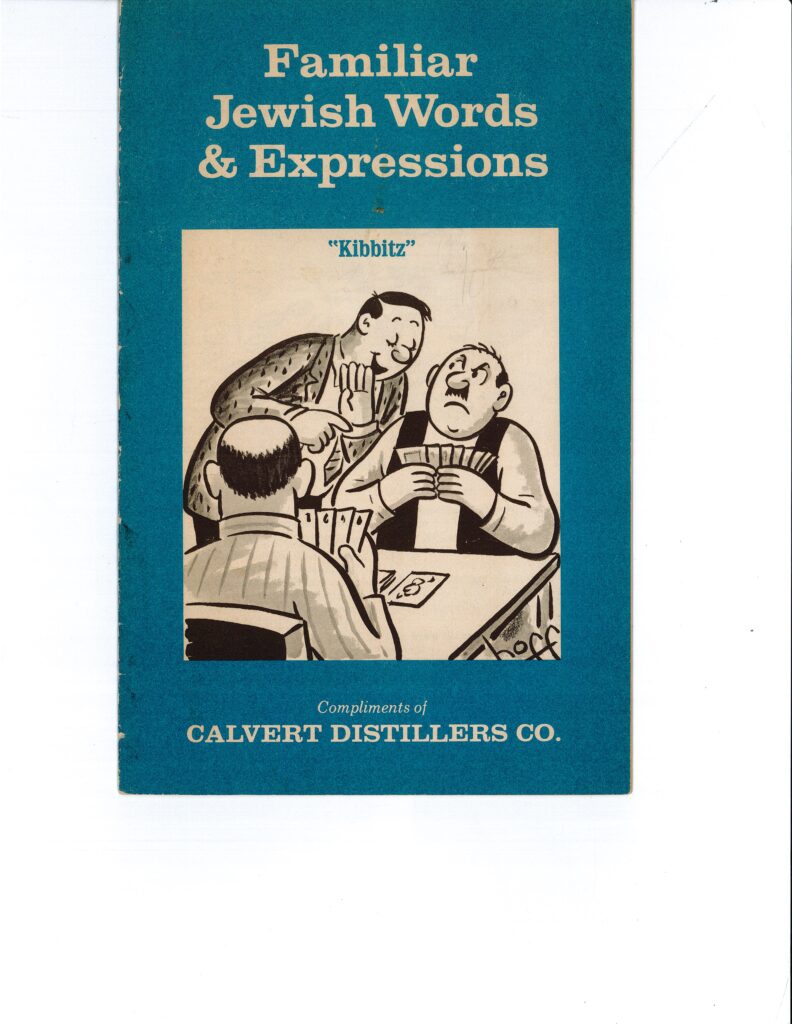
You’ll Hear It on the Midway … but What Does It Mean? (McKennon 1993; see Figure 4) looks like it might be destined similarly for commercial partners rather than all consumers, but in fact it was produced for “widespread distribution.” A glossary of carnival terms, it was published by Gold Medal Products, which provides the midway’s machinery: popcorn poppers, cotton candy makers, and the like. It is much more product relevant than the glossaries previously described, but it’s also lexicographically aware, and on that score it’s worth quoting the preface at length:
This book is being brought to you by Gold Medal Products Company in an effort to record […] a colorful “slice of Americana” that might otherwise be lost forever in the years ahead.
Of course, one way of ensuring that it survives is to eat lots of food at the carnival, literally eating a slice from a pizza warmer, and thus supporting Gold Medal Products. As long as there’s a Gold Medal Products Company, there will always be a carnival.
Of course, all of this information is in the “public domain”—and, unlike the author of dictionaries used in the schools and the libraries, this dictionary makes no attempt whatsoever to assign a correct usage to any words or phrases. This is simply the way it is.
Thus, Gold Medal captures a general view of dictionary authority, avoids prescriptivism, and out describes the descriptivists. Dictionaries are word books, of course, but they are also culture books, something too often overlooked by both dictionary makers and dictionary users, but clear as a bell rung by Gold Medal:
Please bear in mind this is a documentary, telling it like it was. If some of this midway history is offensive to you, we apologize on behalf of whoever created each midway slang term,
which is how you know the compiler(s) of You’ll Hear It on the Midway aren’t lexicographers, who never apologize. Optimistically, the preface reports,
For more copies of this “Dictionary” of Amusement Industry Midway Slang, contact Gold Medal Products or your Gold Medal dealer.
The scare quotes are inevitable in a discussion of this text and other commercially motivated word books—it’s a dictionary on the edge of its genre, one reason it’s so interesting.

Like the Calvert Handbook, You’ll Hear It on the Midway exceeds expectations, which may lessen its marketing value. It comprises 731 entries over 63 pages from preface to colophon. Some definitions are synonymic glosses, while others are encyclopedic, paragraph-long explanations rather than the crisp, semantically focused definitions of the professionally made dictionary. Some of the vocabulary it records overlaps with other jargons or slang more generally (e.g., fuzz ‘police’, gandy dancers ‘railroad track workers’, juice ‘electric current’, sawbuck ‘ten-dollar bill’), but most of it represents carnival life specifically (see Figure 5). I, for one, did not know until reading You’ll Hear It on the Midway, that carnival folks call “An off the road trouper’s urge to get back with it on the road” itchy feet, nor did I understand the distinctions among those who call us to one or another exhibit, show, or activity: “TALKER, (NEVER BARKER): The man who makes the ‘outside openings’ and ‘talks’ in front of an attraction. If he talks inside the attraction, he is a ‘lecturer.’” In fact, the entry at BARKER explains that it’s not a carnival or circus word, but a term imposed by the uninformed, “never used on outdoor shows to denote a talker, spieler, grinder or lecturer.” To the dictionary’s credit, it includes entries for grinder, lecturer, and talker, but it’s still an amateur production—it lacks an entry for spieler, which, in the interest of cross-references and defining vocabulary, no professional lexicographer would allow.
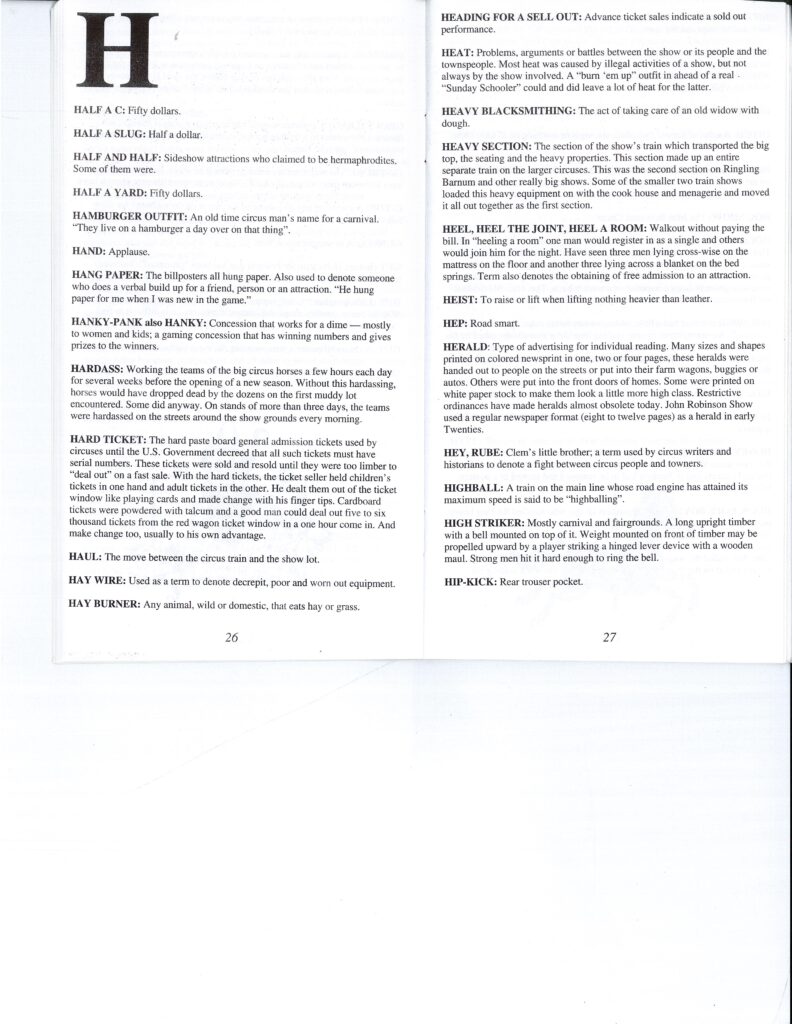
You’ll Hear It on the Midway projects a seriousness we don’t find in the promotional Dictionary of Tanbark Talk distributed by the Ringling Brothers and Barnum & Bailey Circus. This little pamphlet includes 151 entries, double column, over just eight pages, and size leads to arbitrary selection of items: here you’ll find the spieler missing from You’ll Hear It on the Midway, but barker, grinder, lecturers, and talkers are all absent from Tanbark Talk. The glosses are spare but informative. For You’ll Hear It on the Midway, joey ‘clown’ comprises the whole entry, but Tanbark Talk ventures an etymology: “derived from Joseph Grimaldi, a famous clown in England of the 18th century,” which GDoS confirms, with an initial quotation c1815. Given the differences in word lists, structure, and entry-level information, the commercial producers of such dictionaries clearly had different audiences and different ideas about how to engage them.
With just these few examples of commercially motivated glossaries or “dictionaries,” one anticipates an inevitable typology of them, a sub-typology of “lay” or “vernacular” dictionaries, which is in turn a typologically complex category of dictionary, connected by dotted lines to dictionaries of facetious tone, topical dictionaries, and other types one finds in schemes proposed by Yakov Malkiel (see Adams, forthcoming) and Landau (2001, 7–42). Just on Malkiel’s terms, one sees significant variation in Range, Perspective, and Presentation among just these few examples. But I resist constructing a typology of marketing dictionaries from such a small if suggestive sample. Simply, there are more such dictionaries of more kinds than history has yet to consider, which means more lexicographers and dictionary users of various kinds than history has accounted for, too. Some additional exhibits here may serve to underscore that point.
Les Blair, owner with Geanie Blair of Ozark-Made Candy Kitchen, compiled Jest Tawk: A Country Dictionary (1986; see Figure 6) as a premium for their customers. At fifty-two pages between brightly colored covers, this book—“spiced with country sayins”—may have been slipped into bags with the Blairs’ compliments or may have sold at the register for $2.00, which is what the copyright page says a copy costs by mail. Most of the entries record local pronunciations of common words, which makes it like many another corner store or roadside dialect dictionary. These lexical reflections on local American culture participate in the social construction of dialects, the process called “enregisterment” (see Agha 2009; or Adams 2018, for a friendlier introduction). Once speech is recognized by others as different, speakers of what then is identified as a dialect eventually own their speech by commodifying it. So, one purpose of Jest Tawk is to project local identity, another is to use local identity to support brand identity and sell candy. If you saw Jest Tawk on a friend’s coffee table, you’d be sure to stop by Ozark-Maid Candy Kitchen the next time you passed through Osage Beach, Missouri.
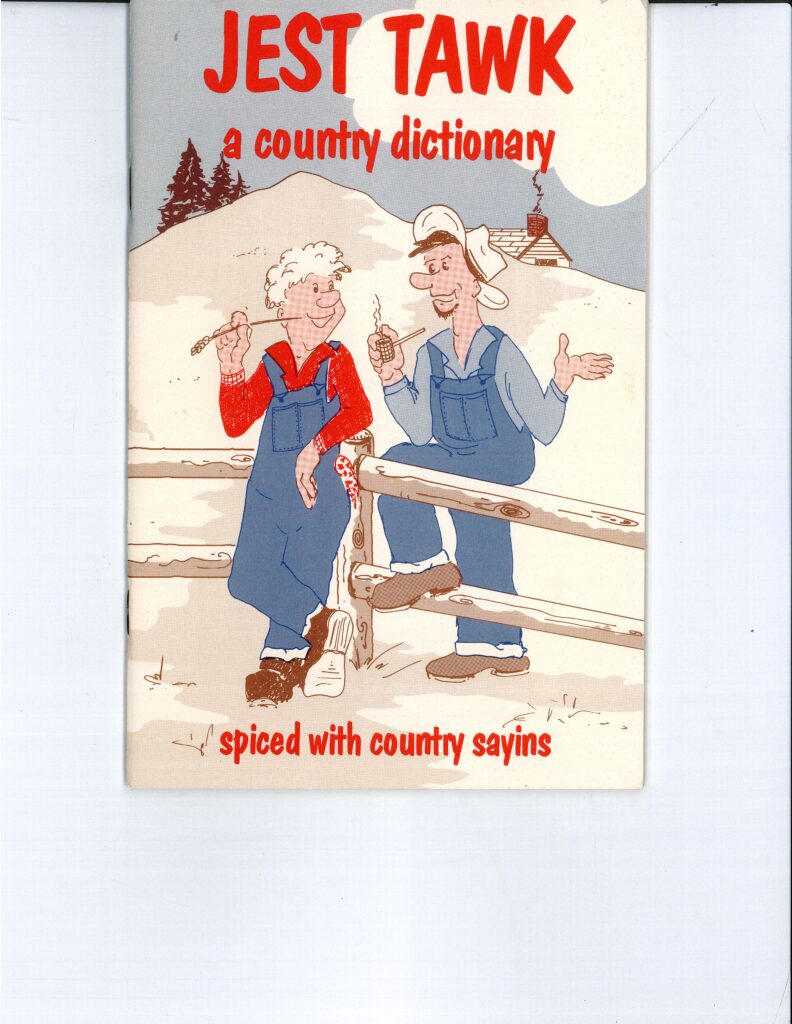
Among dictionaries that serve a commercial purpose, linking lexis to brand community, are those by publishers fortifying the status and appeal of their publications. The authors of these are usually professional writers rather than candy-makers and small business owners, though not usually professional lexicographers. So, Gareth Branwyn compiled Jargon Watch: A Pocket Dictionary for the Jitterati (1997) for readers of the technology magazine Wired, with mixed results. The entry “Jitterati 1. What the digital generation becomes after tanking up on too much coffee. 2. Fear and anxiety associated with not knowing the latest jargon, acronyms, and buzzwords of the Digital Revolution,” for instance, defies some basic principles of defining, even given latitude for jocular presentation.
Hoping to amplify its relationship with its disreputable readers, Viz, the disreputable but popular British adult comic magazine, provided three editions of Roger’s Profanisaurus (Farquar-Toss 1997) as a disreputable bonus wrapped around some issues in the late 1990s. The level can be gauged from A—“air biscuit n. Fart; botty burp”—to Z— “zuffle v. To wipe one’s cock on the curtains after having sex in a posh bird’s house”—but we must not be distracted from the work’s lexicographical zeal nor its amateurism, for a professional would never leave us unsure of whether the sex had been with the posh bird or with someone perhaps less posh in the posh bird’s house. Let me assure you, if you cringe at what I’ve quoted here, the Profanisaurus offers much worse examples.
Regardless of such quibbles, it’s interesting to see purveyors of words give yet more words to their publications’ consumers in dictionary form. Is it the generic variation, the difference between magazine and dictionary, that adds value, or is it the clarity with which the dictionary form introduces readers to “their” lexis, the lexis that partly forms the group identities of which the magazines are hubs? The Profanisaurus speaks to Viz readers and consolidates that group, as does Jargon Watch for the so-called jitterati—their facetiousness doesn’t speak to the unlike-minded. Such dictionaries thus support intrinsic identity work, whereas the Calvert-sponsored Yiddish dictionaries, You Heard It on the Midway, and Jest Tawk—devoted to projecting group identity to those outside the group—support extrinsic identity work. Lexicographically, this sociolinguistic distinction complicates the typology of commercially motivated dictionaries and glossaries. From a marketing perspective, however, it illustrates that different types of brands require different management strategies.
Perhaps the most likely successful of dictionaries compiled for marketing purposes aren’t credibly dictionaries at all. Every example so far has been a booklet, but eight-panel foldouts better serve the marketer’s purpose: they are easy to handle, easy to slip into a bag, easy to read, cheaper to produce—they maximize the ratio of brand message and consumer attention. Capitol Records, which issued such albums as The Big Sounds of the Drags! and Hot Rod Rally Various, not to mention the Beach Boys’ Little Deuce Coupe, collaborated with Hot Rod Magazine on a foldout of Hot Rod Jargon (Medley 1963), containing 154 items, briskly glossed, with lots of illustrations, and synopses of the Capitol albums. Despite its brevity, it captures consumer attention much more readily than the Calvert Handbook, and it does so, as the font fold announces, “Free!!” That’s exactly the right cost for a promotional item.
A foldout for Noah’s Bagels in San Leandro, California, is a more compelling example of this type of commercial “dictionary,” called, in fact, Noah’s Old New York Yiddish Dictionary (Alper 1996; see Figure 7). Any Bay Area bagelry, a Manhattan maven might argue, suffers from an authenticity problem that only a connection with New York City and Yiddish could solve, and Noah Alper attempted to solve it in his case with another free, easily bagged, visually attractive foldout, but one that exploits the semiotics of dictionaries more effectively than any of the other works discussed here. They have columns, bolded entry words, in one case part-of-speech labels—clearly, the authors of these marketing productions have dictionaries in mind. But Noah’s Bagels has top-of-page guide words and numbered senses, liberally uses “lit.” for “literally” as a label—“bubeleh 1. (lit.) little grandmother”—and, perhaps most impressively, embellishes the text with faux thumb indexing, because, of course, thumb indexing helps one finds one’s way around an unwieldy book and serves no purpose at all in an eight-panel foldout (see Figure 8). Thus, the foldout draws facetiously on the authority of dictionaries to fortify a brand and develop a brand community.
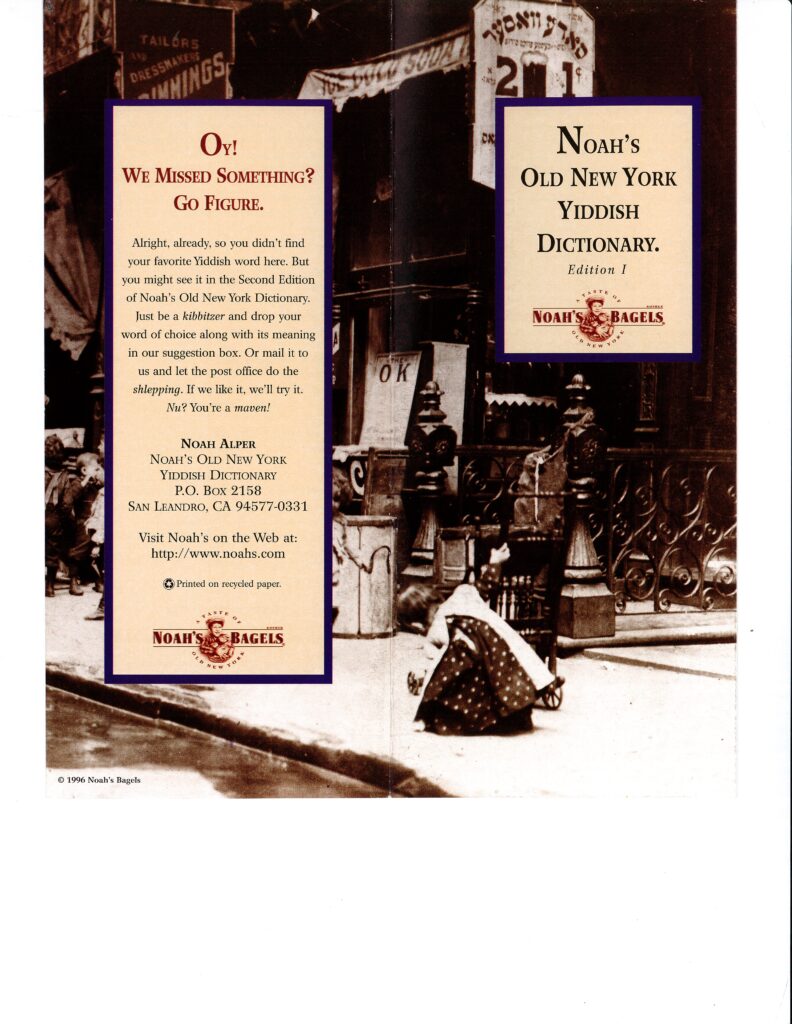
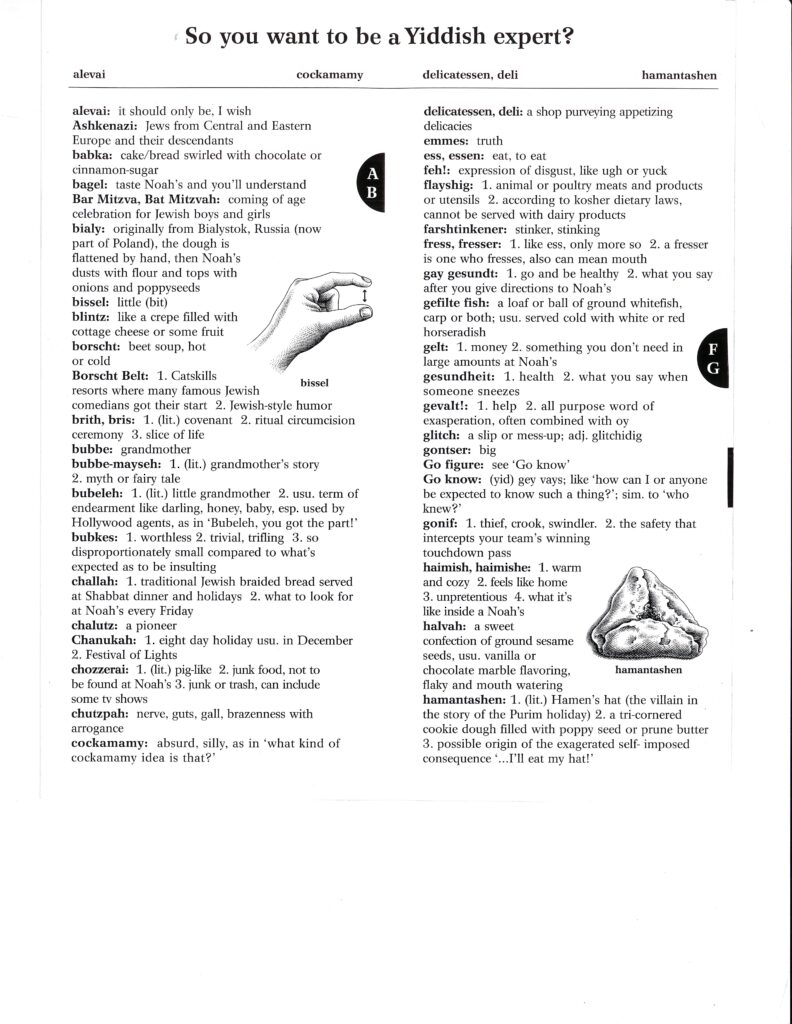
Many will find it difficult to accept foldouts or even the booklets previously described as “dictionaries,” just because dictionaries are supposed to be books. Yet, in the digital age, we know that isn’t true (see, for instance, Nkomo 2020). Does size determine the genre? Of course, it might, as in the differences among short stories, novellas, and novels, though the boundaries between them blur. In 1996, Turner Broadcasting promoted a marathon of gangster movies with a set of flash cards titled Gangster Speak; in 2007, the Golden Gate National Parks Conservancy promoted Alcatraz prison with a set of giant playing cards titled Alcatraz Inmate Slang—cards with words and definitions, yes, but not books, not dictionaries, most would say. But what if we connected the cards with spiral wire? Would they undergo bibliometamorphoses and become dictionaries then? Pimlico and Laurel Park racetracks distributed—free or for a nominal fee, it’s not clear—a clever guide to racing terms (see Figure 9), not many terms, it’s true, and, one might argue, obviously not in dictionary form, less so, in fact, than any other item described here so far. To view the definition of a term, one pulls the card inside the sleeve down or pushes it up so that the bar aligns with a term. The definition appears in the window towards the bottom of the sleeve. It’s not a page-turner, like a dictionary, but what is the difference, conceptually, between turning a page to find a definition and pulling a card down to reveal a definition in a window?
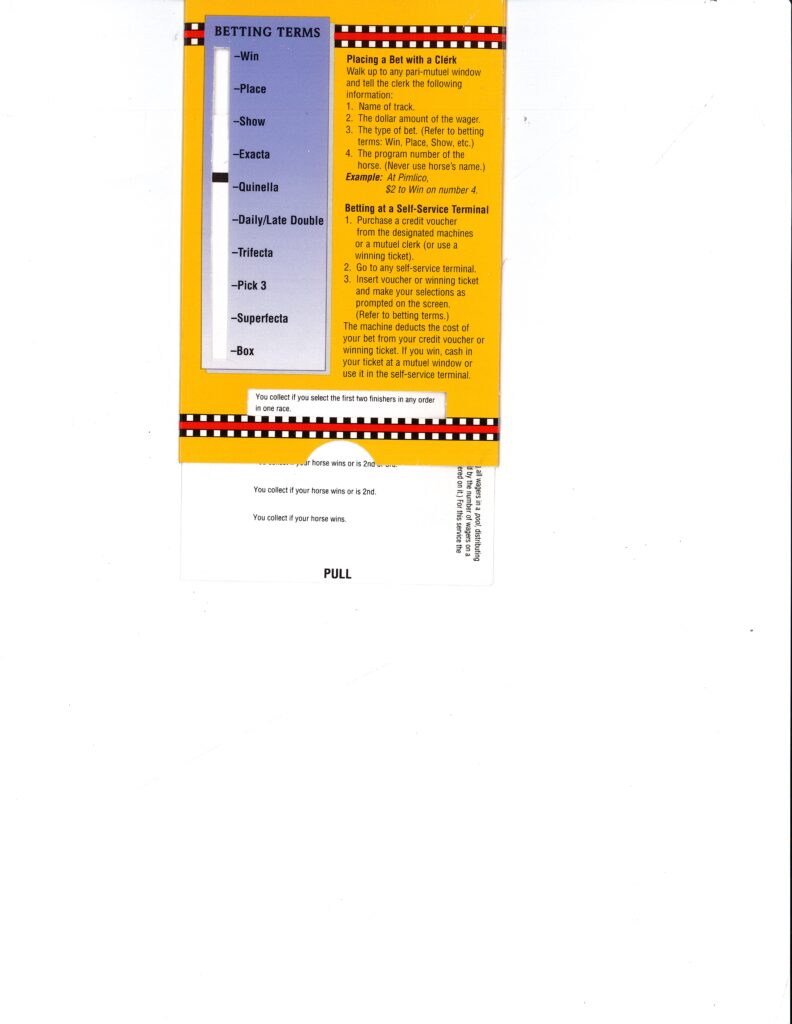
One value of accounting for commercially motivated glossaries, dictionaries, or other word finders lies in this theoretical problem: what counts as a dictionary? The corollary concern is who counts as a lexicographer? Hartmann and James (1998, 41/a) define dictionary as “A type of reference work which presents the vocabulary of a language in alphabetic order, usually with explanations of meanings,” which doesn’t dignify the sort of work described here, not reference work but commercial work, not the vocabulary of a language, but the vocabulary marketers think makes the case for a product or service (Bergenholtz 2012 loosens the definition a bit in ways that align better with dictionaries that support a non-dictionary brand of good or service). A lexicographer “engages in lexicography, either as a compiler or a metalexicographer” (Hartmann and James 1998, 84/b), and lexicography is “The professional activity and academic field concerned with dictionaries and other reference works” (Hartmann and James 1998, 85/b; see also Gouws 2012), which excludes amateur compilers concerned with marketing rather than dictionaries per se.
I believe that lexicographers—the ones defined as such by themselves—should expand the definition to include all amateurs. Who could object to an amateur painter or pianist? Their love of the arts enriches and often even improves their practice. Amateur lexicographers attest to the importance of words and meanings and the examples of professional lexicographers and professionally made dictionaries—amateurism is a compliment. I wish that schoolteachers would ask their students to make dictionaries in the way they ask them to write essays and poetry and paint pictures and make tie racks in shop—I’d like people to see lexicography as a means of world fashioning and cultural interpretation, that is, as an aesthetic practice. If we can entertain t-shirt lexicography (Klosa-Kückelhaus and Stähr 2020) or the appropriation of dictionary style into artists’ books (Russell 2020)—and I think we should—then we can take commercially motivated lexicography seriously, as a further subgenre of the vernacular lexicography subgenre.
If we do, then typology expands the history of lexicography, admitting types of dictionary formerly unnoticed, if not excluded on principle. The history in question isn’t merely that of dictionaries and lexicography, that is, the making of them, but also the history of use and reception of dictionaries or, the examples presented here suggest, innumerable histories of making, use, and reception. Typologies aside, each dictionary has its own histories, as well as contributing to the history of lexicography writ large. Finally, there is no adequate history of lexicography that overlooks dictionaries put to uses other than the canonical ones lexicographers identify. We need to estimate the total range of lexicographical activity, professional or amateur or somewhere in between, and appreciate the roles dictionaries play in all walks of life. Especially, dictionaries and glossaries that support a variety of human activity other than looking up words enact readings of and attitudes about traditional dictionaries and the art and craft of lexicography—we mustn’t overlook that history, either. One surprising feature of reception of these dictionaries is the assumption that they not only inform but entertain, that consumers who become readers of marketers’ dictionaries or dictionary-like works take pleasure in them, which is not an assumption of most professional lexicographers about user engagement with their dictionaries.
What strikes me most in the examples of commercially motivated lexicography I’ve compiled here is the extent to which they involve identity—the identities of business owners, the identities of work-for-hire lexicographers, the identities of consumers. The question of how such dictionaries engage identity deserves much more attention than I can afford it here—it is an open field of importance, not only to metalexicographers, but to marketers. We’re tempted to say that these little dictionaries and foldouts often reflect or express identities of owners, makers, and readers, which is surely true, but only partly, because identity is not static. These dictionaries also help to construct identity, not just brand identity, but the identities of those associated with the brand, at least insofar as consumer identities are shaped partly by participation in brand communities.
For the dictionary makers, identity issues mingle thoroughly with the commercial ones. Paul Gaffey compiled a little dictionary of Australian English, The Wonders of Oz (1990; see Figure 10), for the benefit of tourists who stop at the Hotel Intercontinental in Sydney. His brief foreword (see Figure 11) touches on identity, some of it communal—the dictionary “is meant to serve as an addition to the rich heritage in Australia, that emerges through our unique use of language”—some of it personal—he was an expatriate for a while, and his “status as an author is relatively unknown” in his country of origin. The dictionary would remedy that, he suggests. He thanks Wolfgang Grimm for commissioning the book that would help him recover his Australian-ness and establish him as an Australian author.

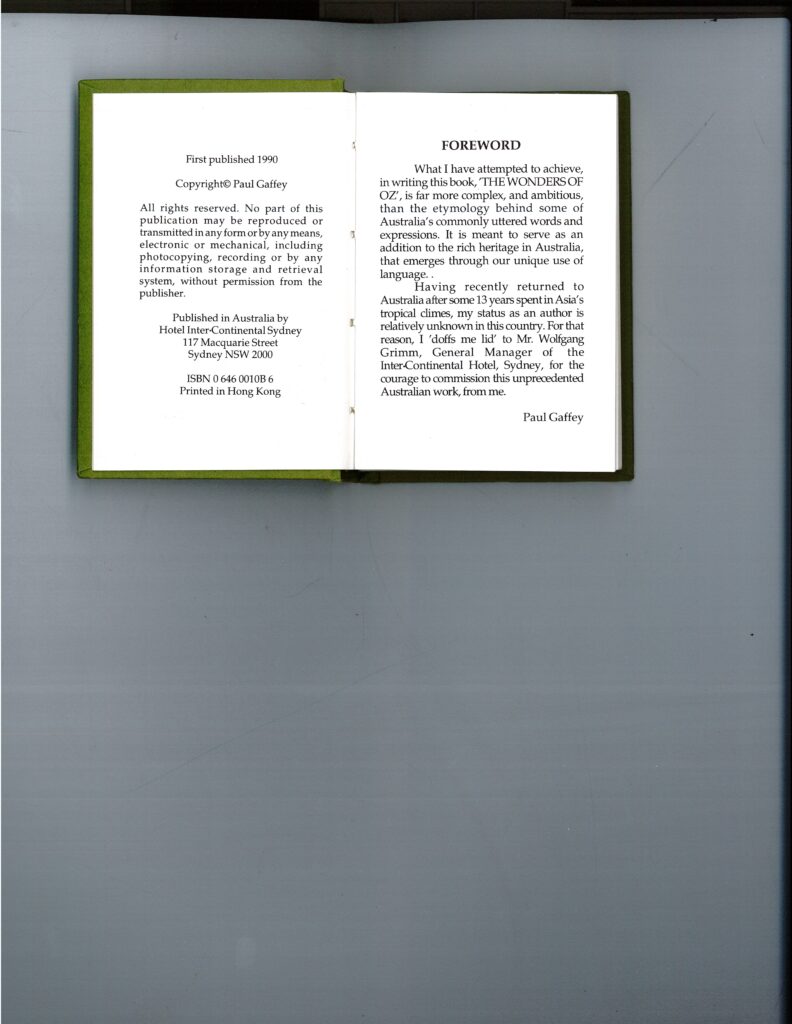
For his part, Grimm was delighted to produce The Wonders of Oz. The commercial enterprise afforded him a lexicographical opportunity, just as the lexicographical enterprise afforded him a commercial opportunity. In taking it, he became a dictionary publisher, and an inscription in one copy of the dictionary shows him identifying as one: “To Kevin: From one publisher to the other” (see Figure 12). Some publishers and official lexicographers might disagree with the claim, but it reminds us that the history of lexicography is not only about lexicographical processes and products but about lexicographical people, too, and everyone involved in the works described here belongs in that category to some degree. They bring words, meanings, and the authority of the dictionary to readers who might otherwise not think much of them, by meeting them where they buy and sell, work and live.
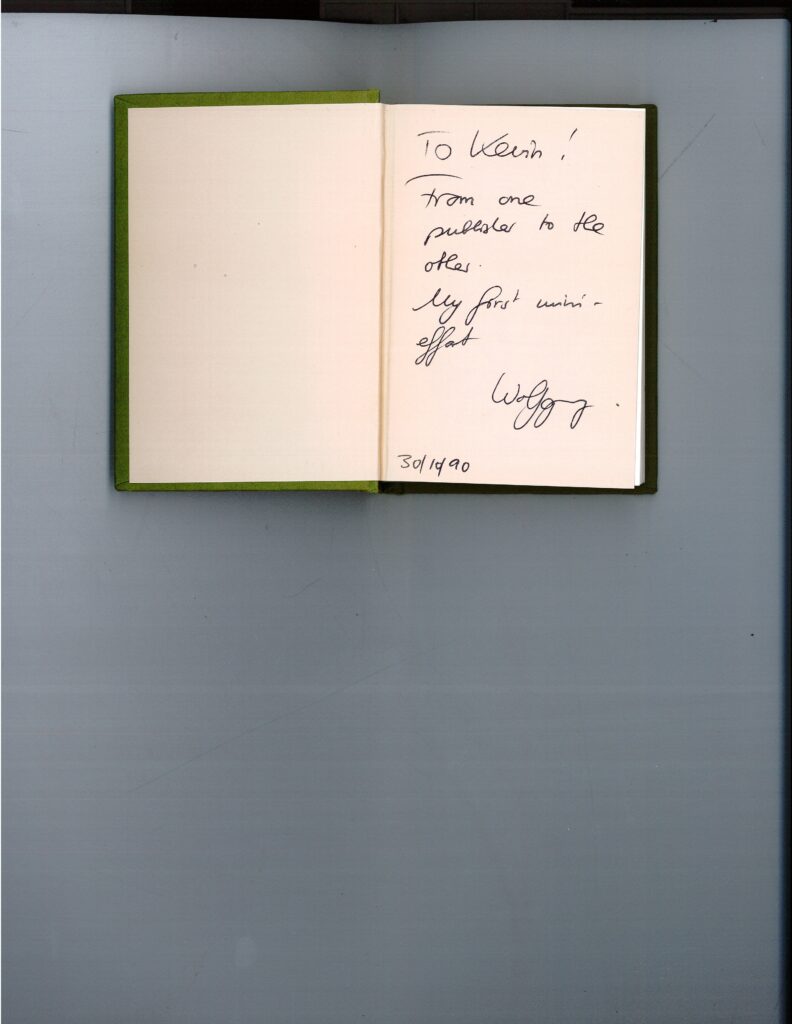
References
Adams, Michael. 2018. Place names and enregistered identity of Michigan’s Upper Peninsula. Names 66: 186–92.
Adams, Michael, ed. Forthcoming. Problems in Lexicography: A Critical/Historical Edition. Bloomington: Indiana University Press.
Agha, Asif. 2003. The social life of cultural value. Language and Communication 23 (3–4): 231–73.
Alcatraz Inmate Slang. 2007. San Francisco: Golden Gate National Park Conservancy.
Alper, Noah. 1996. Noah’s Old New York Yiddish Dictionary. San Leandro, CA: Noah’s Bagels.
Bergenholtz, Henning. 2012. What is a dictionary? Lexikos 22: 20–30.
Blair, Les. 1986. Jest Tawk: A Country Dictionary. Osage Beach, MO: Ozark-Maid Candy Kitchen.
Branwen, Gareth. 1997. Jargon Watch: A Pocket Dictionary for the Jitterati. San Francisco: HardWired.
Dictionary of Tanbark Talk. N.d. N.p.: Ringling Bros. and Barnum & Bailey Circus.
Familiar Jewish Words and Expressions. N.d. Illus. Syd Hoff. New York: Calvert Distillers Co.
Farquar-Toss, Ribena de. 1997. Roger’s Profanisaurus. Newcastle-upon-Tyne: The House of Viz.
Gaffey, Paul. 1990. The Wonders of Oz. Sydney: Hotel Intercontinental.
Gangster Speak. 1996. Atlanta, GA: Turner Broadcasting System, Inc.
Gouws, Rufus. 2012. Who can really be called a lexicographer? Lexikos 22: 217–25.
Green, Jonathon. N.d. The Language of Food: A Short History of Food Slang Compiled for Batchelors Supernoodles. London: The RED Consultancy.
Green, Jonathon. 2010. Green’s Dictionary of Slang. 3 vols. Edinburgh: Chambers.
Hartmann, R. R. K, and Gregory James. 1998. Dictionary of Lexicography. London and New York: Routledge.
Jacobs, Joseph. 1956. The Joseph Jacobs Handbook of Familiar Jewish Words and Expressions. New York: Joseph Jacobs Organization.
Klosa-Kückelhaus, Annette, and Lotta Stähr. 2020. T-shirt lexicography. Dictionaries 41 (2): 93–113.
Landau, Sidney I. 2001. Dictionaries: The Art and Craft of Lexicography. New York: Cambridge University Press.
McKennon, Joe. 1993. You’ll Hear It on the Midway … But What Does It Really Mean? Cincinnati, OH: Gold Medal Products Co.
Medley, Tom. 1963. Hot Rod Jargon. Los Angeles: Capitol Records.
Nagy, Andrea. 2004. Life or lexicography: How popular culture imitates dictionaries. Dictionaries 25: 107–21.
Nkomo, Dion. 2020. Vernacular lexicography in African languages: From early days to the digital age. Dictionaries 41 (2): 213–43.
Racing Terms/Betting Terms. 1994. Culver City, CA: Jack Nadel, Inc.
Russell, Lindsay Rose. 2020. Dictionary, shaped: Artists’ books and lexicography. Dictionaries 41 (2): 115–46.
Thorne, Tony. 2014a. Dictionary of Contemporary Slang. Fourth edition. London and New York: Bloomsbury.
Thorne, Tony. 2014b. The Word on the Street: The Spitfire Guide to Street Slang. Faversham: Shepherd Neame.
